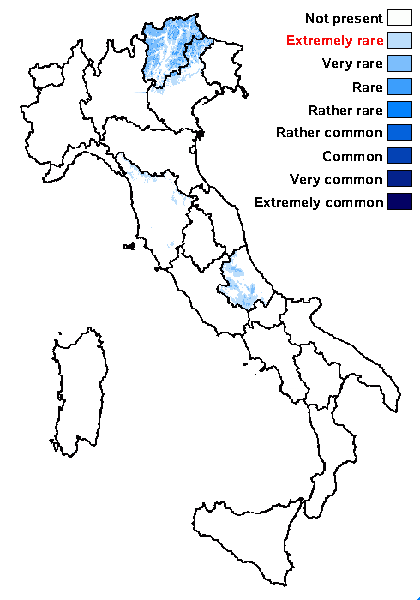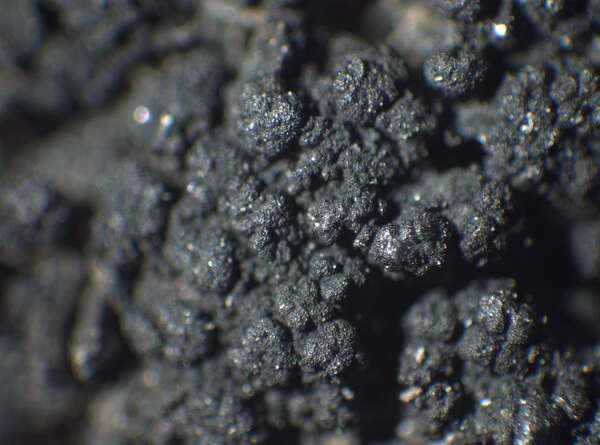Micarea turfosa (A. Massal.) Du Rietz
Svensk Bot. Tidskr., 17: 94, 1923. Basionym: Biatora turfosa A. Massal. - Ric. Auton. Lich. Crost.: 128, 1852.
Synonyms: Lecidea turfosa (A. Massal.) Jatta; Lecidea verrucula (Norman) Th. Fr.; Lecidella verrucula (Norman) Stein; Micarea verrucula (Norman) Hedl.; Oedemocarpus turfosus (A. Massal.) Trevis.
Distribution: N - Ven, TAA. C - Tosc, Abr.
Description: Thallus crustose, episubstratic, continuous, blackish grey to brown-black, subgelatinous when wet, up to 70 μm thick, forming up to 3-5 cm wide patches, the outer hyphae with a dark green pigment reacting K-, N+ red. Apothecia micareoid, usually numerous and often confluent, 0.1-0.3(-0.4) mm across, red-brown to black in sun-forms, with a convex to subglobose disc, without a distinct proper margin. Proper exciple poorly developed but usually visible in very young apothecia, reddish brown, of radiating, branched and anastomosing hyphae; epithecium and upper part of hymenium blue-green, K-, N+ red; hymenium 35-50 mm high, greenish in upper part, sordid brown in lower part; paraphyses numerous, branched and sometimes anastomosing, 1-1.5 μm thick at mid-level, the upper cells 1.5-3 μm wide; hypothecium scarcely differentiated from the hymenium, mottled reddish brown, 70-140 μm high, K-, N- or N+ orange-brown. Asci 8-spored, clavate to cylindrical-clavate, with an unstained wall and a K/I+ blue outer layer and apical dome, the latter with a non-amyloid, cylindrical axial mass. Ascospores (0-)1-3-septate, oblong-ellipsoid to spindle-shaped, sometimes slightly curved, (10-)12-21(-25) x (3.5-)4-5 μm. Pycnidia immersed, inconspicuous, to 0.04 mm across, the wall sordid green, K-, N+ red. Conidia cylindrical, 3.5-5 μm long. Photobiont chlorococcoid, the cells 4-7 μm wide. Spot tests: thallus and apothecia K-, C-, KC-, P-, UV-. Chemistry. without lichen substances.
Note: a circumboreal-montane species found on acid peaty soil, terricolous bryophytes, more rarely on rotting wood in upland areas, reported from the Eastern Alps and the Northern-Central Apennines. Records from Central Italy, although not impossible (Nimis 1993: 437), require confirmation.
Growth form: Crustose
Substrata: soil, terricolous mosses, and plant debris
Photobiont: green algae other than Trentepohlia
Reproductive strategy: mainly sexual
Commonnes-rarity: (info)
Alpine belt: very rare
Subalpine belt: rare
Oromediterranean belt: absent
Montane belt: extremely rare
Submediterranean belt: absent
Padanian area: absent
Humid submediterranean belt: absent
Humid mediterranean belt: absent
Dry mediterranean belt: absent

Predictive model
Growth form: Crustose
Substrata: soil, terricolous mosses, and plant debris
Photobiont: green algae other than Trentepohlia
Reproductive strategy: mainly sexual
Commonnes-rarity: (info)
Alpine belt: very rare
Subalpine belt: rare
Oromediterranean belt: absent
Montane belt: extremely rare
Submediterranean belt: absent
Padanian area: absent
Humid submediterranean belt: absent
Humid mediterranean belt: absent
Dry mediterranean belt: absent

Predictive model
 Index Fungorum
Index Fungorum
 GBIF
GBIF




